Review: Chance Theater Offers Ambitious 'Intimate' Production of Still Timely Epic RAGTIME
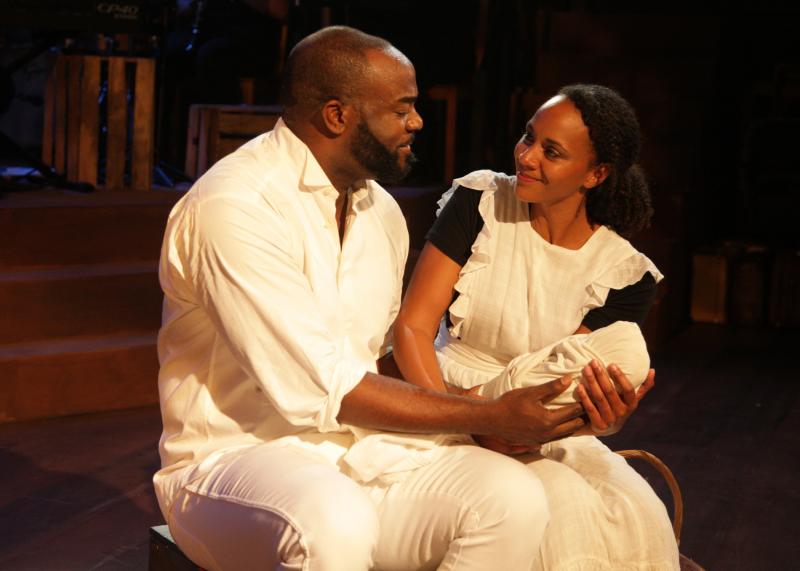
First, a confession. Whenever someone asks me what my favorite stage musical of all time is, my definitive answer has remained the same for two decades: RAGTIME.
Besides its riveting encapsulation of turn-of-the-20th-century America---mixing both real figures from history interspersed with fictionalized characters that represent the diverse communities that made up the nation in 1906---the musical also features beautiful ragtime-infused music from composer Stephen Flaherty and lyricist Lynn Ahrens that are filled with lush orchestrations, meaningful, memorable lyrics, and powerfully expressive highs and gentle dramatic lows that blend seamlessly with every story arc and narrative vignette from Terrence McNally's bountiful book.
On a more personal level, RAGTIME deeply connected with me both as a person of color and as an immigrant who came to this country with my entire family to become American citizens and, of course, to pursue that American Dream.
RAGTIME, in the broader sense, speaks (and sings) eloquently about the attainment of that dream---which, funny enough, proves to be an often common, shared desired amongst people who are different from one another.
A sweeping, grandiose, and emotionally-searing Broadway musical adaptation of E.L. Doctorow's expansive 1975 novel, RAGTIME is also, compared to most stage musicals, a noticeably large-scale, epic undertaking---a gripping, multi-character, and multi-story theatrical experience that uses era-authentic specificity to depict America's past during a time when its increasingly diverse population has been forced to adjust to the ramifications of new technological, social, political, and economic changes that are spreading throughout the nation.
For some, this change is a good thing.
For newly arrived immigrants---then mostly from Eastern Europe---America promised better living conditions that finally freed them from devastating persecution, giving them a plausible chance to improve their status of life.
For African-Americans, the changing times---merely a handful of decades since slaves were emancipated---gave them hope for a more substantial increase in overall fairness and equality, to endure less discrimination, to earn enough to own goods and property, and, yes, to have hope that they will face less violence directed at them for the color of their skin.
For the scandal-plagued, change meant the ability to use their notoriety to become an overnight celebrity (which, ideally, should come with a better than average paycheck).
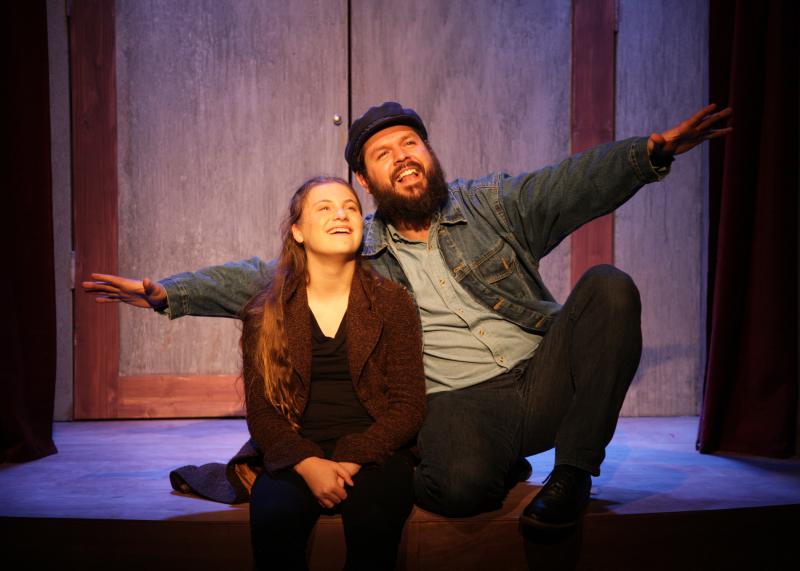
For wealthy whites living comfortably inside their bubble of privilege, what they want the most, for the most part, is to lead happy, fulfilling lives. For many in the group, though, leading happy lives means never having to deal with the "other"... "those people" that don't look like them or sound like them or act like them.
And then for the titans of industry, advances in the use of raw materials and the development of innovations like mass production meant bigger earnings and bigger success---which, on the down side, usually opens up incidents of unfair labor practices that affected mostly those on the very bottom of the economic hierarchy. But fortunately, they love the notion that the "cream rises to the top."
And all this info is just from the opening prologue---which, for me, remains one of the best opening numbers ever featured in a stage musical.
Of course, today's audiences while absorbing all these scenes can't help but observe that, eerily, many of these very same issues are somehow still top-of-mind today, particularly in recent years with the surge in anti-immigrant policies and sentiments, the increasing gap between the rich and the poor, and, of course, the horrific rise of racist sentiments and, worse, racist acts against people of color.
Who would have predicted 100 years ago that our country would become so divided yet again more than a century after the events of RAGTIME took place, despite all the encouraging progress that has since been implemented?
Perhaps this overarching motif---that many of these era-specific issues that RAGTIME's characters struggled with in 1906 are still alarmingly present in 2019---is the true motivator behind director Casey Stangl's impressive, "intimate" theater reimagining of RAGTIME for Chance Theater.
In this brand new, impressively-realized regional revival---now on stage in Anaheim through August 11, 2019---audiences both new and/or familiar with the source material will not be able to ignore the troubling parallels between our ongoing present and the oh-so-distant past. Actually, it's rather difficult not to notice because that parallel isn't even disguised in this production's overall emboldened approach.

But I must issue a warning... If you're only looking for a "faithful" production of RAGTIME that hews closer to the original---that is, with period-specific external components like billowing, era-appropriate antique costumes, authentic turn-of-the-century set facades, or a cast numbering in the 40's---then this production may not be up your alley (though I might still attempt to convince you to try it out anyway).
Scaling down the musical's normally large footprint on all fronts---except, arguably, for its emotional resonance---Chance Theater's more "intimate" but still compelling presentation of RAGTIME is an ambitious and still impactful iteration that, for the most part, retains much of the heart and soul of the original beloved musical, while doing so in a fresh way that audaciously allows the present day to peek through in plain sight---not so subtly making the irrefutable case that the struggles of yesterday can still be eerily relatable today.
And because of this same motif of showing the "present informed by the past," this production also feels more like a self-aware, elaborate staged concert version---but still with all the drama and emotion of a full-fledged book musical.
With this in mind, scenic designer Christopher Scott Murillo's static but cleverly comprehensive set is an intriguing mashup of a modern-day industrial warehouse but decorated with giant gears and metallic surfaces reminiscent of those seen in turn-of-the-century factories and steam engines. Even better, Murillo uses many inventive details and features that allow his useful set to easily stand in for (and convert into) 1906 structures in a very abstract way that forces you to reassess the visuals as representative rather that an accurate reflection of realism.
In collaboration with props designer Danthi Tran, an upright piano, a passing ship, or even a brand-spanking new Model T Ford are brought to life not with actual props or sets that visually resemble their real-life counterparts, but rather with deconstructed objects where the missing connective components are filled in with your imagination. Thus, simple wooden crates turn into a piano, and a squared-off bench on rollers becomes the seating carriage of a car. By all accounts, this RAGTIME is purposefully blurring the line between retro and modern.
Similarly, Wendell C. Carmichael's costumes for the characters curiously lean more toward modern-day, off-the-rack garb, but accentuated subtly with early 20th Century-looking fabric or stylistic touches as a means to casually connect the past to the present. Thus some are still in jeans, others in modern cut t-shirts or blouses---hardly the kind of clothing you'd see in 1906.

But, surprise! I really bought into their creative treatment. While the cynical person in me could have just as easily dismissed these "touches" as nothing more than just a way to be different, or to comply with budgetary constraints, but for me, it was an ideological statement. Overall, Chance Theater's truly inventive RAGTIME still successfully conveys the musical's criss-crossing stories quite well, even with the many understandable short cuts it needed to implement. Overall, their efforts are well worth experiencing, not only for the sheer talent of the production's assembled cast, but also for its ability to achieve similar emotional resonance that a larger-scaled production would have also elicited.
And after seeing Pasadena Playhouse's recent reimagined production of this same musical earlier this year and now Chance Theater's even fresher iteration, I am really enjoying the many ways the local So Cal stage community has been tinkering creatively with this now classic musical in brilliant, new ways.
For their admirable production, Chance Theater's RAGTIME begins even before a single musical note is even heard. (Warning, SPOILERS ahead for those wanting to see this superb staging themselves).
As the show begins, the entire cast---all dressed in essentially modern 21st Century garb---quietly all enter from what looks like a large garage door on one end of the elongated set. They all enter the scene with the serious, determined demeanor of an acting troupe that has taken over the space and is about to put on an unsanctioned, guerrilla-style play chockfull of raw emotions.
On the onset, the cast is noticeably fewer in number than in what a typical production of RAGTIME would employ, as is its six-person on-stage band led by musical director Robyn Manion. But fear not, because the smaller numbers of this production's ensemble and band do not at all diminish its power and resonance.
But something else is also noticeable that took me by surprise: the cast is not as evenly diverse as one might have expected in a production of RAGTIME. Let's table this for now.
Soon, the memorable opening piano notes of the introductory prologue begin and the ensemble collectively starts to switch their attitudes, signaling that they are now leaving behind their 21st Century personas and are now switching into character-acting mode. They begin to augment their modern-day wardrobes with, curiously, only slight era-appropriate touches to give their outerwear just a hint of its connection to the past.
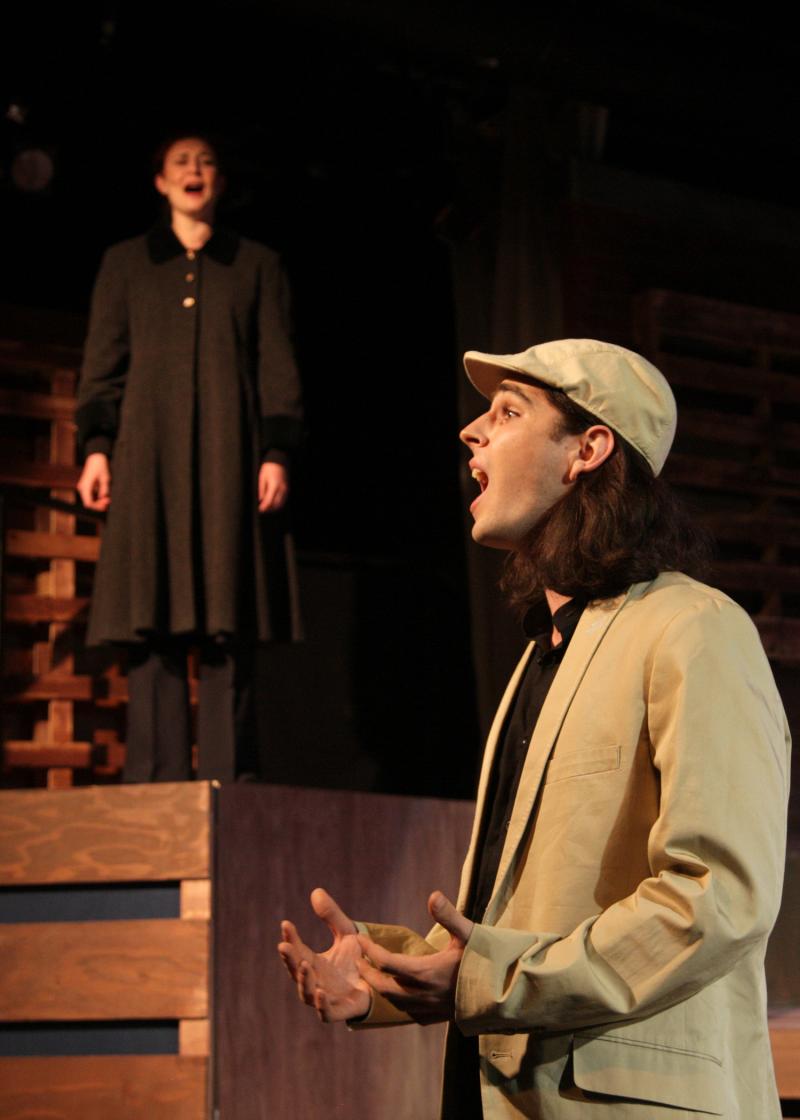
Joseph Bricker
Much of the opening prologue is a dizzying, frenetic whirlwind of activity as actors zip and zoom across the stage in a fascinating traffic pattern to plant themselves in different areas of the set depending on when they are in the exposition-heavy opening song. The show's smaller ensemble, naturally, calls for cast members to do some double- and triple-dipping into various smaller ensemble roles, and, frankly, I am amazed at how well each actor is able to create distinctive personas with each "new" appearance.
Typically the people introduced in this opener belong to one of three groups: the wealthy, finely-dressed white folks of New Rochelle, the darkly-clothed European immigrants carrying all their worldly possessions, and, finally, a group of African-American men and women from Harlem. For Chance Theater's RAGTIME, I was a little surprised that these groupings were, um, unevenly balanced---but becomes less noticeable whenever they break off from these three scripted clusters.
This is perhaps my only gripe with this otherwise uniformly superb production. This gripe, I'm afraid, lingered occasionally---primarily because the musical at its very core is such a specific testimonial about the need for progress, equality, and racial harmony that seeing this slight misstep iseems counterproductive to the musical's message.
But I digress.
Back to the opening prologue... as tiny enhancements to their wardrobes continue, a few actors even take the time to help their peers ceremoniously put on their added wardrobe pieces as well, as if they are all in one united tribe about to begin a sacred ritual.
That ritual, of course, involves the dramatized stories and historical vignettes explored in RAGTIME, which centers primarily on three main characters from the three distinct communities that make up this "new" dawn of America. Each of these characters is embarking on their own respective journeys as they try to stake their earned places within the nation.
On one side is Mother (Rachel Oliveros Catalano), a kind, pleasant WASP-y woman who lives a quiet upper-class life of privilege with her wealthy family in the protectively non-diverse bubble of New Rochelle, New York. After Mother's husband (Ron Hastings), who often tells her what to do and yet frequently takes her for granted, decides to cater to his whims and sail away from home to go off on an expedition, Mother is left behind once again to oversee their family business, raise their peculiar son Edgar (Brendan Knox), and to run their household that also includes her Younger Brother (the impressive Joseph Bricker) and cantankerous Grandfather (Glenn Koppel).
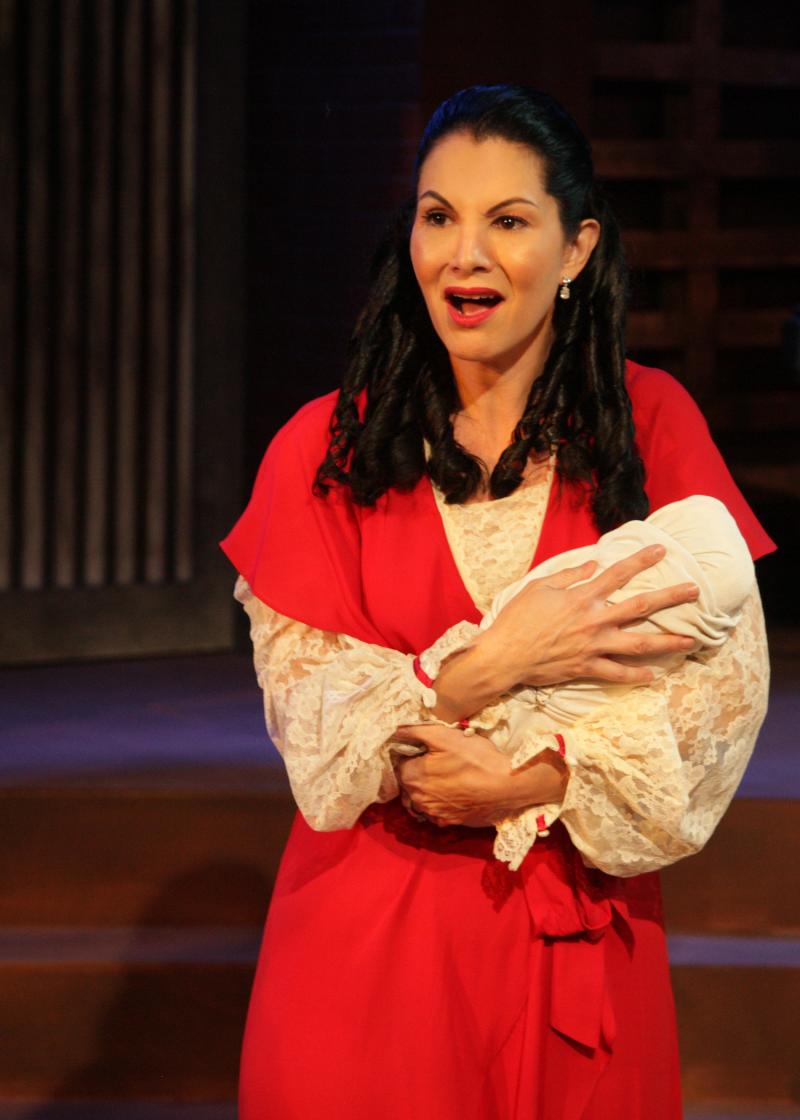
Across the ocean on a "rag ship" bound for America's Ellis Island is Jewish immigrant Tateh (the terrific Wyn Moreno) who along with his young daughter (Rebeka Hobllik) has just escaped the harsh conditions of their Latvian shtetl only to end up living in one of the many poor immigrant tenements on the Lower East Side. Tenacious and creative, Tateh is determined to make it in his new home, especially for the sake of his daughter.
And finally we meet Ragtime musician Coalhouse Walker, Jr. (the excellent Dony Wright) a charismatic, strong-minded Harlem piano man who despite his flaunting his debonair lifestyle still often expresses his regrets for losing the love of his life, Sarah (the gorgeous-voiced Jennifer Talton) who ran off. In a strange coincidence, Sarah and her newborn baby are taken in by Mother, forcing Coalhouse to drive and make frequent visits to New Rochelle in order to win Sarah back. In the process, he becomes friendly with Mother's family---that is until Father returns home from his expedition and becomes irate that Mother would allow such "strangers" to be in their house.
Despite their disparate backgrounds, these three main characters---and their extended relations---become somehow interconnected by both coincidence and circumstance---and, yep, a new type of music called Ragtime.
In the midst of all this interconnected drama, RAGTIME also takes the time to introduce us to some key figures of the day which includes radical anarchist Emma Goldman (Bryce Hamilton) who often raised the loudest voice against the status quo on behalf of people like Tateh; Model T creator and mass production pioneer Henry Ford (Hastings in his second role); African-American activist Booker T. Washington (Jabriel Shelton); master illusionist and immigrant success story Harry Houdini (Matt Takahashi), and scandal-plagued celebrity vaudeville performer Evelyn Nesbit (the enjoyable Sarah Pierce) who turned her infamy from a murder trial into a stage career that has her "on the swing."
Once again, Chance Theater, in their laudable version of RAGTIME, demonstrates what this local small theater does consistently well when it comes to staging smaller-scaled versions of musicals that are normally a lot grander in all facets: its knack for making sure the material still resonates while having to accommodate it within the smaller space it occupies. They did the same with superb earlier of productions of PARADE, HAIRSPRAY, IN THE HEIGHTS, and BLOODY BLOODY Andrew Jackson to name just a few.
It also helps that the themes explored in this musical---from racism, bias, misogyny, and xenophobia to the attainment of celebrity through scandal---is still very much relevant, and perhaps more so, in today's world, making it all the more clear just how timely and powerful RAGTIME has been and continue to be. From its anthemic music to its dense portraits of different Americans, this melting pot musical proves to be just as beautiful as a large or small production (of course, depending on how well it is cast and directed).
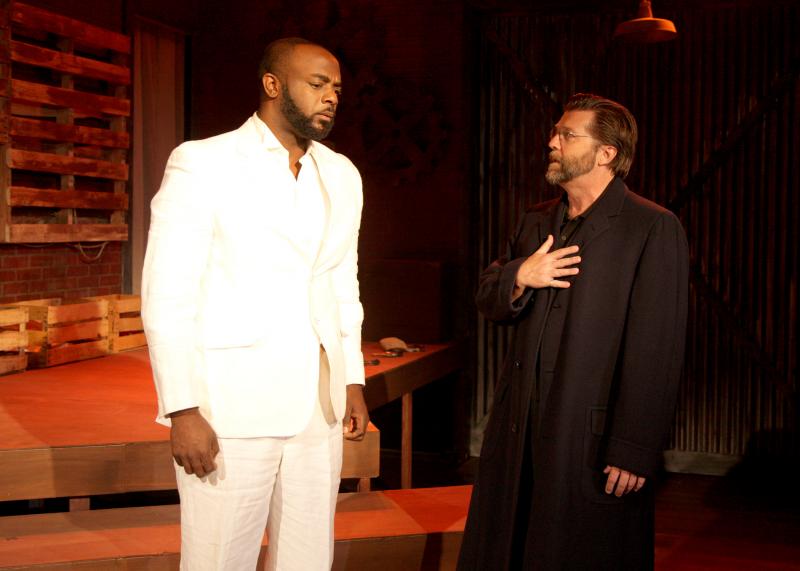
While, yes, I would have preferred to see more African-American cast members in the ensemble to play, oh, members of the African-American community assembled for certain moments in the show, the well-meaning intention of featuring other minority actors in their stead was, um, a baby step (thankfully, at the very least, Coalhouse, Sarah, Sarah's friend, Booker T. Washington, and Coalhouse Walker III were each portrayed rightfully by the five exceptional African-American cast members in the show).
Despite this hiccup, Chance Theater's otherwise admirable iteration doesn't lose its thematic and emotional power even though it sacrificed some of the original's imbedded grandeur. But the good side effect that occurs is that the cast's close juxtaposition to the audience makes for more vulnerability and immediate expressiveness to come pouring out in the cast performances. Whichever way you happen to be looking, you'll glimpse a cast member immersed in the scene, never breaking character even if they're not necessarily the focus of the moment.
And when they are In Focus, we get stunning results. Wright, Catalano, and Moreno all give exceptional renderings of their respective characters. Chance has found a rising star in Bricker (who makes you take notice with each appearance), and Hastings, Talton, and Hamilton make memorable turns in their supporting roles. Yunga Webb, who plays Sarah's friend and various other roles throughout the show deserves a special shout-out for her stunning lead vocal in the show's act one finalé, "Till We Reach That Day" which drew tears from, ahem, certain audience members during the opening night performance.
Other aspects worth mentioning include Kelly Todd's dynamic choreography that made great use of the space, as well as Manion's noteworthy musical direction (and lead piano playing) of the show's ad-hoc band that valiantly attempted to replicate the sounds of a score normally performed by a huge symphonic orchestra.
With its ambitious scope, its history-glazed storytelling, and its beautiful, memorable music, RAGTIME remains, for me, a work of theater that thoughtfully and purposefully embraces the strong ideals of inclusion and diversity---ingredients that America needs to continue to nurture in order to be, well, great. Much like what this musical warns against---unfounded hatred, racial bias, unfair inequality and having an irrational fear over the influx of immigrants whose only goal is to pursue better lives free from danger and persecution---we need to look upon our current troubles so that we don't keep repeating the same mistakes as a nation.
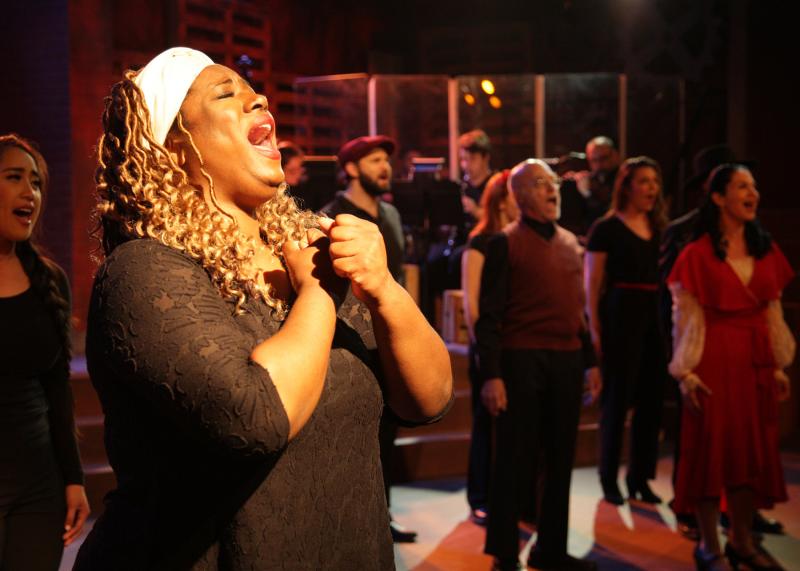
And just like America itself, the musical is not completely free from flaws either, but, overall, the sum of its glorious parts make for one of the most gripping musicals ever created. Even in its smaller scaled production (and despite a casting short cut), Chance Theater with RAGTIME has another winning show in their lineup that's worth checking out.
Follow this reviewer on Twitter: @cre8iveMLQ.
-------
Photos from Chance Theater's production of RAGTIME THE MUSICAL by Doug Catiller, True Image Studio.
Chance Theater's Production of RAGTIME has been extended and now continues on the Cripe Stage through August 11, 2019. The Chance Theater is located in the Bette Aitken Theater Arts Center at 5522 E. La Palma Ave., Anaheim Hills, CA 92807. For more information or to purchase tickets, call (714) 777-3033 or visit www.ChanceTheater.com.
Reader Reviews

Videos

